Tablet Store 10.1″ iPhone-styled Windows 7 3G Tablet
- Surprisingly good value OEM netbook/tablet
- What UMPCs should have been
- A flash(back) in the pan from 2010
Because the market for these tablets is now very split – with consumers looking for anything “that might be like an iPad”, whilst the geeks as ever are just looking for the coolest toys – I will address the hardware first, and then the user experience.
Shanzhai gets it right sometimes, and Tablet Store UK’s Windows 7 tablet is one such case. Coming in at £449, with the 3G-equipped model tested at £499 with 160GB HD, HSUPA wireless from a Sierra Wireless 8781 and Bluetooth and WiFi via a combined module, this tablet is also known as the TESO J-10 and iiView M1Touch; it identifies itself as a THD PX1.
While many sites have opted to view this as an “iPad Killer”, such a concept is laughable – it’s an evolution of the Ultra-Mobile PC concept. So where has the concept been taken, and has it matured sufficiently to be worthwhile?
Have China’s fast-acting OEMs cracked something that few startup firms have managed?
Since Tablet Store provided this review sample for me, we’ll overlook the other names of the system from here on in and for the sake of expediency, refer to the system as the WinPad. Snappy, huh? What is important is that it costs £499 in the UK equipped with Atom N450 CPU, 160GB HD, 1GB RAM, 1024 x 600 10″ display (widescreen aspect, a bit like the JooJoo) which supports multitouch and a full complement of wireless connectivity – WiFi, Bluetooth and 3G with vestiges of GPS. The GPS may need revisiting and isn’t an advertised feature…
It starts out as good, solid current, netbook fayre. With the N450 and NM10/GMA 3150 graphics, the WinPad is pretty much ready and waiting for Hackintosh experiments and also represents the more mature, solid end of the netbook market; N-series processors generally seem to deliver better performance than the Z-series, albeit at the expense of greater power consumption.
Dell’s current Mini 10 model is N450/GMA3150 based, for example, and most current netbooks share this Pine Trail chipset.
The display isn’t up to the standard of Apple’s iPad, but remains good across a wide viewing angle horizontally – it’s the twist that lets it down and that’s more apparent on a handheld device than a clamshell. Still – for the money, it’s pretty much industry standard. The 3G/HSDPA wireless comes from a Sierra Aircard MC8781 – equipped with the most current firmware, this hunts slightly for signal compared to a phone but uses a regular SIM and is unlocked. Finally, there’s Bluetooth and WiFi; these are provided on USB by a combined dongle integrated into the machine, and the WiFi finds networks easily.
While Bluetooth was suggested as a path to equipping the device with GPS, the Sierra Wireless MC8781 already incorporates gpsOne capability as long as the right firmware is loaded (AC881U_F1_2_3_15AP).
It also includes the ability to use diversity antenna to improve 3G signal quality; so whilst we can strike one of those items off the list (as supplied from the Tablet Store it has the correct firmware) I’ll take a screwdriver and nerves of steel to see if what else can be achieved with this system. Watch this space.
The GPS capability is definitely functional, though without software to fully test it I’ve been relying on this – NMEA Monitor for Windows. I’m getting visible satellites with the J-10 propped up in a window, but no signal yet; when I’m out on the road with it I’ll see how quickly it gets a fix.
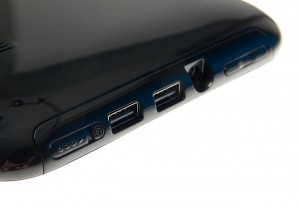
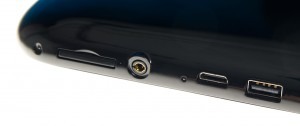
(It’s worth noting that the Dell Mini 10 I reviewed also has GPS on the 3G card, but allegedly requires an antenna. Sadly specifying the TV option on that means the MCX connector is already deployed).
Elsewhere inside the WinPad, we find DDR2 memory that gives a respectable score in the Windows Experience index and a 160GB Hitachi HDD, partitioned into 3 with Windows 7 pre-installed. No installation media is provided, but OEM Windows 7 is included and as always you should make a restore disk – it might be worth using one of those partitions to make a quick recovery disk if you really like to tinker. Along with the Windows index of 2.3, GeekBench gives this system a score of 924 on “Balanced” power when running on battery, and 935 on High Performance – whilst running under Windows 7 Home Premium with some Aero effects switched on. Here the system is also identified as a THD (Thread Technology) PX1.
Physically, you’re confronted with a giant iPhone – seriously, if it weren’t for the aspect ratio and vents you’d be confused by the front – made of good quality plastics. The touch panel is reputedly made by the same OEM as Apple’s own – it’s certainly responsive and offers two touch points (so if it is made by Apple’s supplier, it’s not the same level of hardware), and seems to shrug off the occasional wipe down.
A screen protector would make sense if you’re not prepared to see just how robust it is, however. The home menu button, power button and backlight buttons are the only physical controls on the unit (aside from a small, unlabelled reset switch) and these all feel well made, the power symbol containing the LED points to a fair bit of thought going into the design of the OEM product, as does the ability to use the backlight and menu keys to select and enter startup options.
The fit and finish is good and the whole unit, whilst surprisingly heavy at 1.1Kg, feels pretty well made. An added nice touch is that it’s not bothered about being upside-down – the screen rotates to all four orientations.
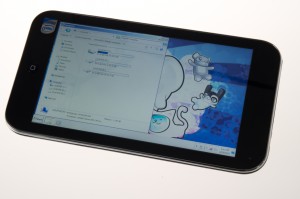
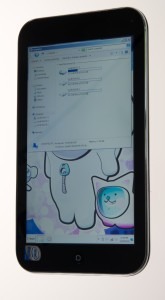
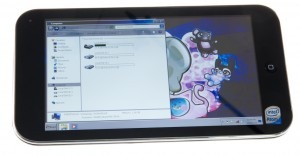

Interfaces include 3 USB 2.0 ports – two on one side, one on the other where it shares space with a mini-HDMI port, power, and audio. No wired ethernet is included on this model, though I have seem OEMs offering a very similar unit with VGA and Ethernet; if you’re overseas and buying a similar model on the strength of this review, those are signs it’s not the right one. Finally the SIM slot, and an SD card reader, complete the hardware interfaces.
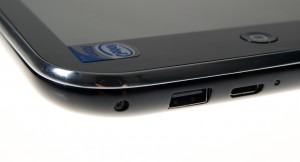

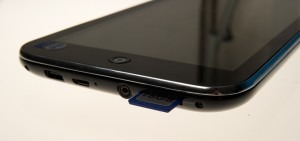
A microphone and 1.3Mp camera are also provided; the camera is quick to activate via the menu button and pretty good for a webcam – do remember that in the natural “pad” user position, we can see up your nose. I recommend using a stand, or nose hair clippers – either one. Please. It’s like the Blair Witch project, only there are two forests… (Please note, I have not at this time included a sample picture from the webcam in use as intended. Have a guess why ;) ).
Where was I? Oh, yeah. Essentially then, if your experience of Shanzhai or OEM products has been stuff like those Windows CE netbooks or Elonex’s feeble attempt to market them here (remember their little… um… One+ thingy? With the rubber keyboard and the CPU power of a washing machine? No. Neither does anyone else, thankfully), you can stop hiding behind the sofa – this is better made than my Dell Mini 10.
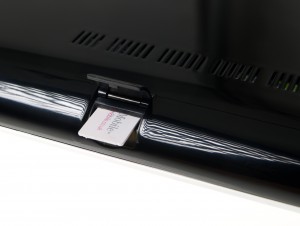
It’s not all roses, of course. The compromise on this system is the battery; there’s also the inevitable side effect of being able to run a desktop OS on a machine this size and get reasonable performance – heat. The battery, which is built in, is around 3000mAh and lasts for around 2 hours at most, and more realistically just over an hour of WiFi and media. That really limits autonomy; my review unit also had a surprisingly short power cable but was rushed to me with an alternative PSU. The heat is not a performance issue, but it does limit how comfortable it is on your lap.
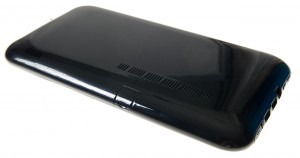
Having said that, as a geek toy it’s pretty awesome. it’ll run your x86 operating systems as well as any netbook, whilst looking kinda funky and going online anywhere. It will also do some fairly serious jobs; I’ve run Camera Control Pro 2 on it for tethered DSLR shooting, have had a play with Lightroom (it runs – slowly, but it runs) and it plays DVD-quality video well. To be honest I chucked some HD rips onto it, and they were perfectly acceptable; no tearing or stuttering, and sync remained – even when played in Windows Media Player. It’s also a neat presentation tool, offering dual-screen and screen spanning functions apparently (an adaptor is required for the full HDMI port size and I don’t have one currently – this will be updated when I’ve tried it). For £499, it represents good value when compared to similar 3G equipped netbooks which don’t have touch screens, though you may find they have better battery life currently.
Naturally, whilst this is from Tablet Store UK, I know geeks will search; IMO the current pricing is worth buying in the UK. I’ve had excellent support from them during the review (not least supplying the system so we could cover it) and the current exchange rate and import duties make any saving either negligible, or more likely to turn into an additional cost.
Given that you’ll be dealing with a UK firm, any issues will be easily resolved and you won’t end up with lost, delayed or faulty hardware – an experience I’ve had with DealExtreme and others have reported from the referral/advertising sites. Now the iPad is well known and popular, the tablet market for clones, knock-offs and misrepresented goods is getting a lot busier – this is a good solid OEM product despite the iPhone-esque styling, and will not be a disappointment if you’ve read the review properly.
Hardware footnote: A listed accessory for this is a case which provides a keyboard. A rubber keyboard. Much like the Elonex One’s, in fact. If nothing else, this machine could be the one for the kitchen, where you can finally risk spilling sauce on the keys when quickly looking up recipes online.
THD PX1/WinPad for non-geeks
It’s no secret that I’ve been impressed with Apple’s iPad. Before it came out, I owned several UMPCs and found them distinctly lacking – and naturally the iPad retains the edge in design, with a 10 hour battery life and a solid app store with some really impressive applications.
Those applications aren’t free, and the iPad is not a Windows machine. Short of recognising that it’s the same money you’d probably spend on either, these are totally different devices. The WinPad is a tablet PC, a proper, x86 computer with proper Windows and proper hard disc storage, to run your proper Windows applications. As such, I’m comparing this to the UMPC devices I’ve had more than I am other tablet devices.
Windows 7 has improved how it behaves with touch screens, compared to XP and Vista. It’s still got a long way to go, but it makes an effort. What helps massively is the multi-touch screen – on the WinPad, a two-point capacitive device. Whilst finger-point accuracy is poor, it allows gestures and pinch to zoom to work; Windows itself needs larger buttons and selection menus/boxes to accommodate the visual/touch interface, it’s by no means a failing of the pad. If you want your ‘iPad equivalent’ to run Windows, sorry – this is what you’re going to get no matter what you do, Windows is not geared up to finger touch yet whether you spend £1500 or £500.
And on that note, you will need to spend about £800-1500, if not more, to get the kind of battery life you get from ARM-based hardware. They need different cooling, different processors, different batteries and different industrial design to eke out that last bit of efficiency, and that costs money. When a Ubiquio VIA-based UMPC was £800, a smaller OQO was £1500, a faster Sony was £1800; even the FlipStart, with its little Pentium M and 5.6″ screen, would struggle to get more than an hour and a half from the standard battery and it got very, very hot – it also cost $1999 or £1500.
If you want to run Windows, these are the compromises you have to make. Sorry.
If you buy the WinPad to run Windows, the build quality and touch screen will provide about the best you’ll find for close to the budget currently. As an alternative to a netbook, let’s see what the accessory case is like; currently the on screen keyboard isn’t great for long-term use; another Windows issue. Nothing on the WinPad has frustrated me (a bad idea for a computer to do when it’s hand-held; tempers are short and hand-held things are easily thrown), all the features have worked as advertised.
So from a consumer perspective; if you want to run Windows on a tablet, this is a great device, the compromises made are clear and obvious, and it’s up to you to decide if you want to make a different set. Most of the alternatives involve as much weight reduction in your wallet as they do in the device, though, and often for cosmetic rather than functional gains. The given rating for this would be higher if the battery life were longer, in terms of performance it’s a good 80% machine.
I’m impressed enough that I intend to try it with more tethered cameras and with Elinchroms’ SkyPort software as a studio controller. There’s a lot of potential due to the acceptable Windows performance and robust-feeling build.











